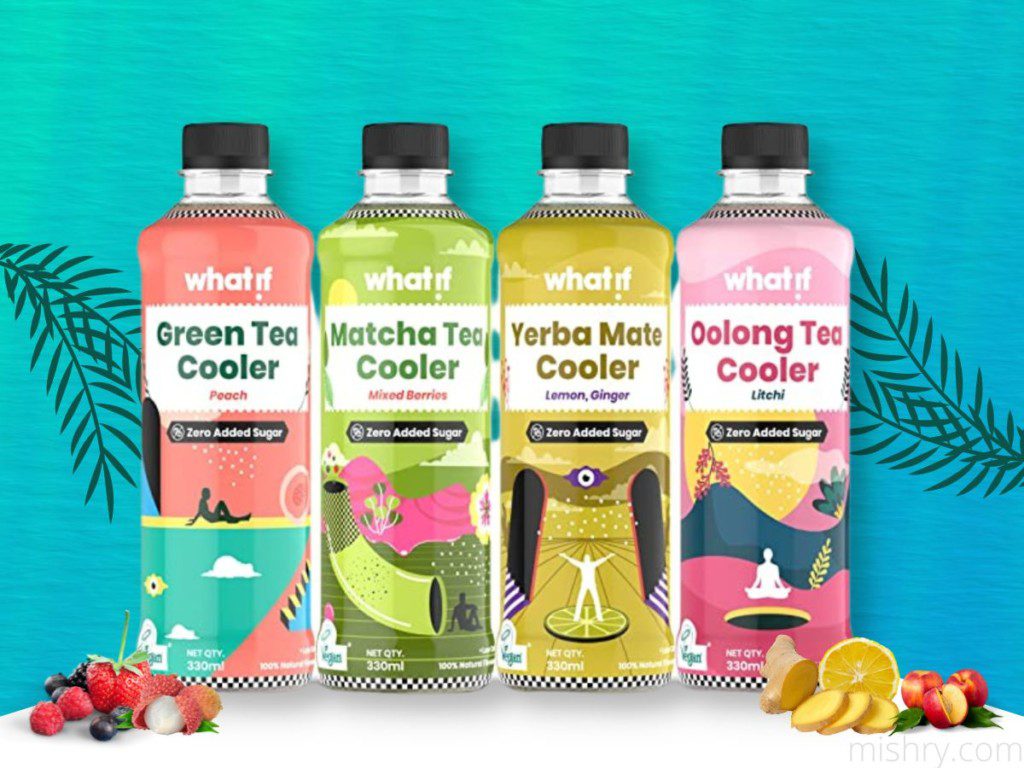Mishry Rating
Summary
Although refreshing and fruity, What If Tea Coolers do not really capture the natural flavors of regional teas. This has more artificial ingredients than natural ones, which is why they have scored low on the nutri quotient.
Does a low-calorie snack or beverage inadvertently mean it is good for you and healthy?
Well, the answer is subjective based on your fitness goals. That being said, ‘no sugar’, ‘low calorie’, and ‘preservative-free’ are attractive phrases that have us adding products to the cart without even realizing it. Testing one such Indian brand, here is our What If Tea Coolers review. We decode the ingredients, the claims, and whether or not this is worth a try.
Are these beverages truly good for you?
Table of Contents
What If Tea Coolers – Quick Glance
| What If Tea Coolers | Mishry Rating | Buy Now |
| Green Tea | 3.1 | On Amazon |
| Matcha Tea | 3.1 | On Amazon |
| Yerba Mate Tea | 3.1 | On Amazon |
| Oolong Tea | 3.1 | On Amazon |
Our Review Factors
1. Flavor
These are flavored coolers made using tea leaves from regions like China, Taiwan, Japan, Latin and South America. They are sweetened using plant-based sweeteners and flavored with fruits or fruit powders.
We reviewed to check how pronounced the flavor of tea was, whether or not the fruit flavor tasted natural, and if the sweetness was rounded.
So, do these coolers work?
2. Consistency
Were they pulpy like fruit juices or did they have a lighter body? Was there some fibrous or grainy mouthfeel?
Or did the coolers feature a uniform consistency?
3. Nutritional Quotient
The quality and quantity of ingredients were recorded under this parameter. How are these sweetened? What plant-based sweeteners are used? How processed are these ingredients?
Do these contain additives? If yes, what is the function, do they have an impact on our internal health?
4. Other Parameters
The price, packaging, appearance were noted here.
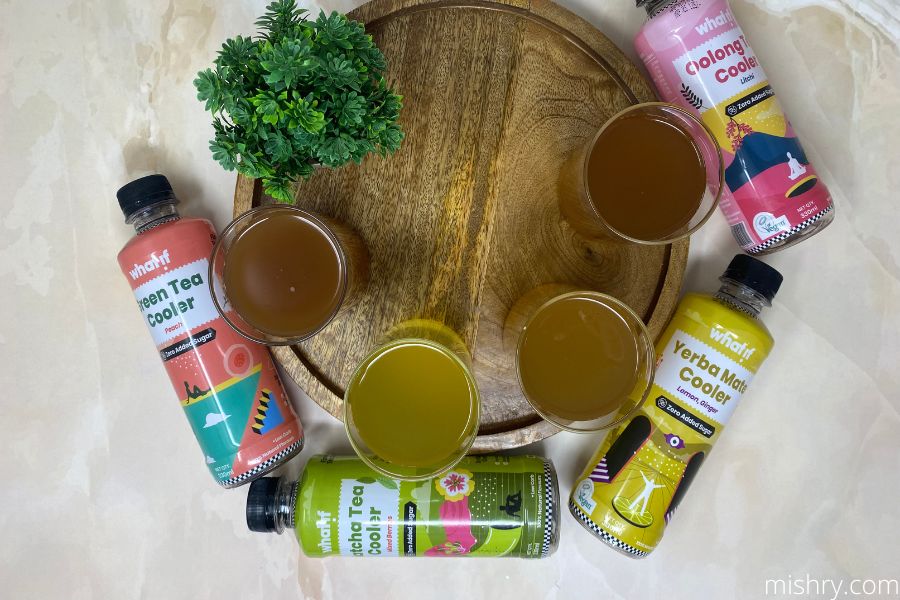
What If Tea Coolers – Detailed Review
Before we detail our experience, we’ve spoken about the characteristic flavor of each tea variant, how it is supposed to taste like, in its most natural form.
The what, why, how of debittered stevia.
Steviol glycosides are the sweetness-lending compounds in stevia leaves. This compound is extracted by harvesting, drying, and purifying the leaves. All steviol contain various forms of microcompounds called Rebaudiosides. The most common is rebaudioside A or reb A. This elimination of glycosides is called debittering stevia. Stevia is an all-natural, healthful alternative to refined sugar, especially for those with diabetes. However, it does have some side effects (in certain individuals) like digestive issues, hives, swelling, etc.
Swimming into sweeteners
Today, we have four categories of sweeteners- sugar, sugar alcohols, artificial sweeteners, and naturally-derived sweeteners. The difference lies in their flavor, composition and caloric value.
Not only are artificial sweeteners low in calories, but they also add viscosity, body, and bulk to the food/beverage. While plant-based sweeteners have a mild bitterness, alcoholic sweeteners may lend a medicinal/industrial flavor.
FSSAI on ‘no sugar’ claims state no sugar has been added either directly or indirectly (via an ingredient) and if sugar is naturally present in an ingredient, they must specify by stating ‘contains naturally-occurring sugar’.
Gut bacteria and additives, friends or foes?
Additives like flavor enhancers, preservatives not only increase the shelf life but also create an addictive flavor. Now, not all scary-sounding, too-tough-to-pronounce additives are harmful. But not all are made the same, either.
For instance, Tocopherol is another name for vitamin E, and Ascorbic acid is vitamin C.
That said, additives like sucralose, carboxymethylcellulose, aspartame, among others aren’t directly linked to life threatening illnesses, but they significantly negatively impact the gut, which in turn, affects absorption and assimilation of micronutrients, deteriorating the overall quality of life. A study on xylitol in mice shows that the gut enzymes were diminished by over 50%.
1. Green Tea
Our Experience
Both, green and Oolong teas, are derived from the same plant but are processed differently. Green tea originates from China and India (Assam). The flavors traditionally depend on the cultivation and processing methods, but they range from grassy to tropical.
As for the flavor of the fruit, we could taste fruity, peachy notes delicately. The sweetness was adequate.
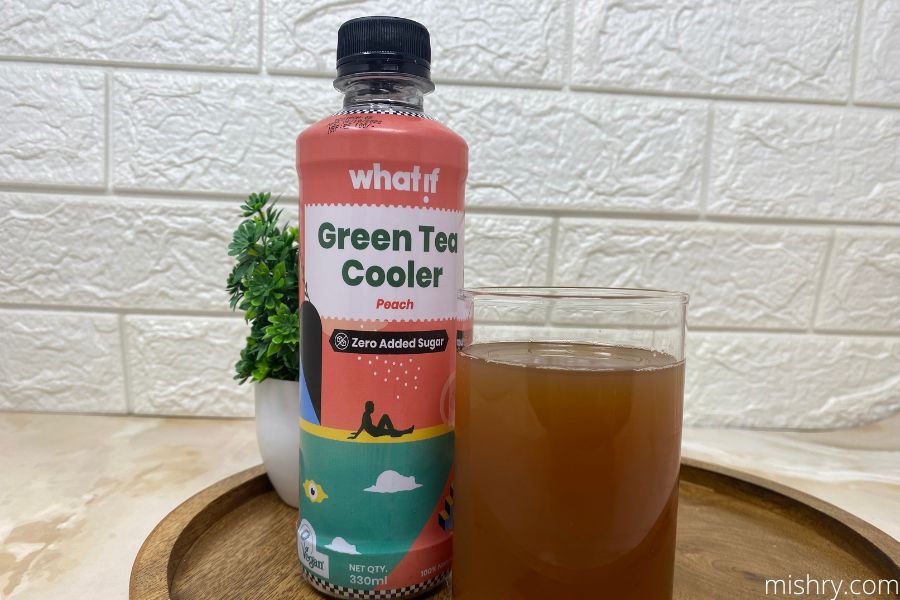
Product Details
It is made with Xylitol (INS967), Green tea extract, Acidity regulators (INS330, INS331), Peach powder, Green tea flavor, Debittered stevia (INS960), Peach flavor, Mint powder, Xanthan gum (IBNS415), Mint flavor, Permitted Class II Preservative (INS242, INS211). One bottle (330 ml) offers under 10 Kcal. This is priced at ₹ 125/-.
2. Matcha Tea
Our Experience
Matcha, originating from Japan, is a tea that holds complex flavors. The mildly grassy, sweet nutty flavor owes to its complex preparation of milling the leaves into a fine powder and whisking in water.
Berries, on the other hand, have sour-tarty notes.
In this What If cooler, we could barely taste the complex flavor of matcha tea. It was primarily a berry-flavored cooler that was dominant on the notes of cranberries and raspberries.
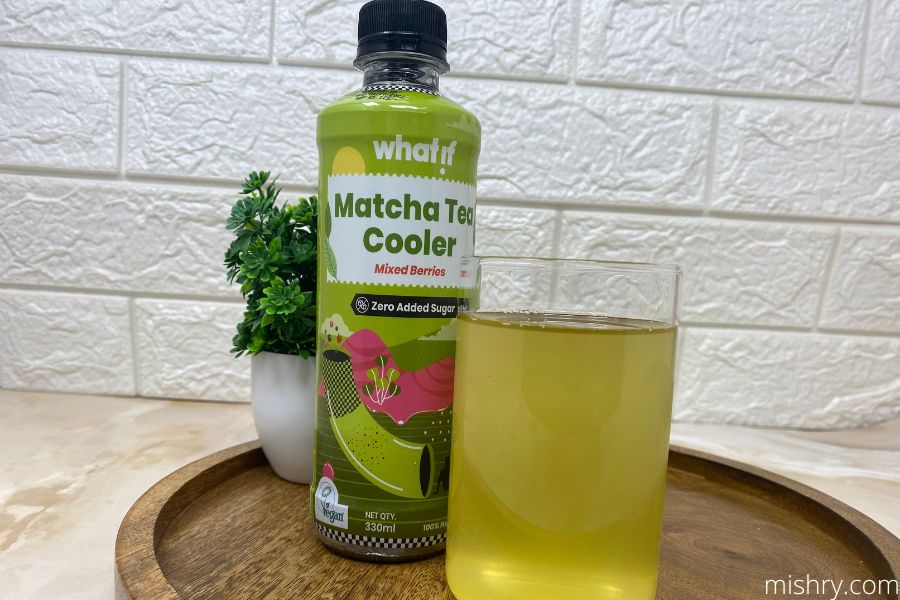
Product Details
Erythritol (INS968), Xylitol (INS967), Acidity regulators (INS330, INS331), Ascorbic acid (INS330), Blueberry flavor, Raspberry flavor, Cranberry flavor, Matcha tea extract, Xanthan gum (IBNS415), Permitted Class II Preservative (INS242, INS211) are the ingredients used. 330 ml is priced at ₹ 125/-.
3. Yerba Mate Tea
Our Experience
Yerba Mate teas have an astringent, vegetal flavor. Commonly compared with coffee, this is a flavor profile one takes time getting used to.
In this cooler, the warming pungency of ginger was present and we got some fresh notes of mint. As for the flavor of Yerba Mate, we sensed a mild astringency with a lingering bitterness at the end of the sip.
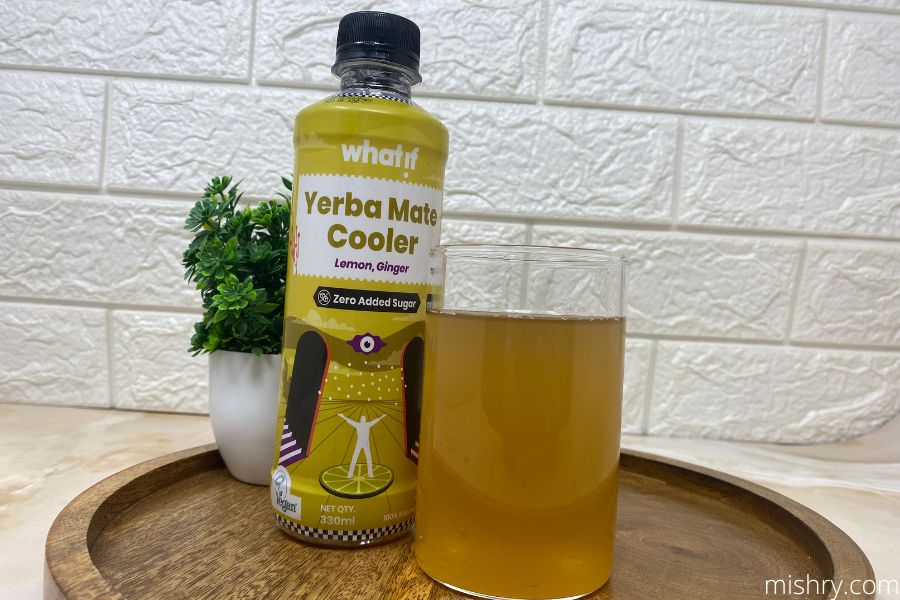
Product Details
Xylitol (INS967), Yerba Mate Tea Extract, Acidity regulators (INS330, INS331), Lemon powder, Debittered stevia (INS 960), Ginger flavor, Lemon flavor, Mint powder, Xanthan gum (IBNS415), Mint flavor, Permitted Class II Preservative (INS242, INS211). It is priced at ₹ 125/-.
4. Oolong Tea
Our Experience
It may be light, it can be acidic, it may be sweet or toasty to taste, that’s the beauty of oolong tea. Owing to its oxidation period, it can lend a range of flavors.
What we tasted here, was primarily sweet. There was a refreshing fruity flavor of litchi mixed with the natural sweetness of Oolong tea. This did NOT have the standard juice-like sweetness, it was more rounded.
A common observation for all variants we tried, these tea coolers have a light, water-like consistency, they do not feel too heavy or filling. The Oolong Litchi variant had a few strands of the fruit, and that’s about it.
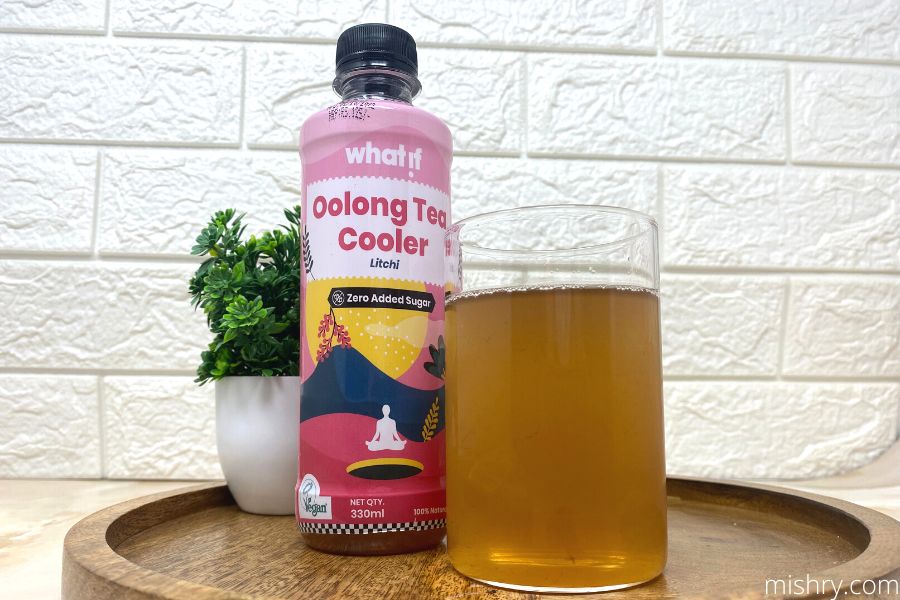
Product Details
Xylitol (INS967), Acidity regulators (INS330, INS331), Litchi powder, Litchi flavor, Oolong tea extract, Debittered stevia (INS960), Mint powder, Xanthan gum (INS415), Mint flavor, Permitted Class II Preservative (INS242, INS211). This variant is priced at Rs 100/- for the same quantity.
Frequently Asked Questions
1. Are these Tea Coolers healthy to consume?
Like we suggest for all packaged products, occasional, mindful, and monitored consumption is key.
2. Are What If Tea Coolers made with real tea?
Some are made with extracts, others have added flavors.
3. Can What If Tea Coolers be used as a mixer for alcoholic beverages?
Not really, these are to be consumed directly.
4. Are Tea Coolers carbonated?
No, these are not carbonated.
5. How long do What If Tea Coolers last once they are opened?
You can store them under refrigeration.
Wrapping Up
Soda, boba tea, milkshakes, what do you prefer?
Our reviews are unbiased and all samples used during the reviews were paid for by us. Read our entire ethics statement here.

